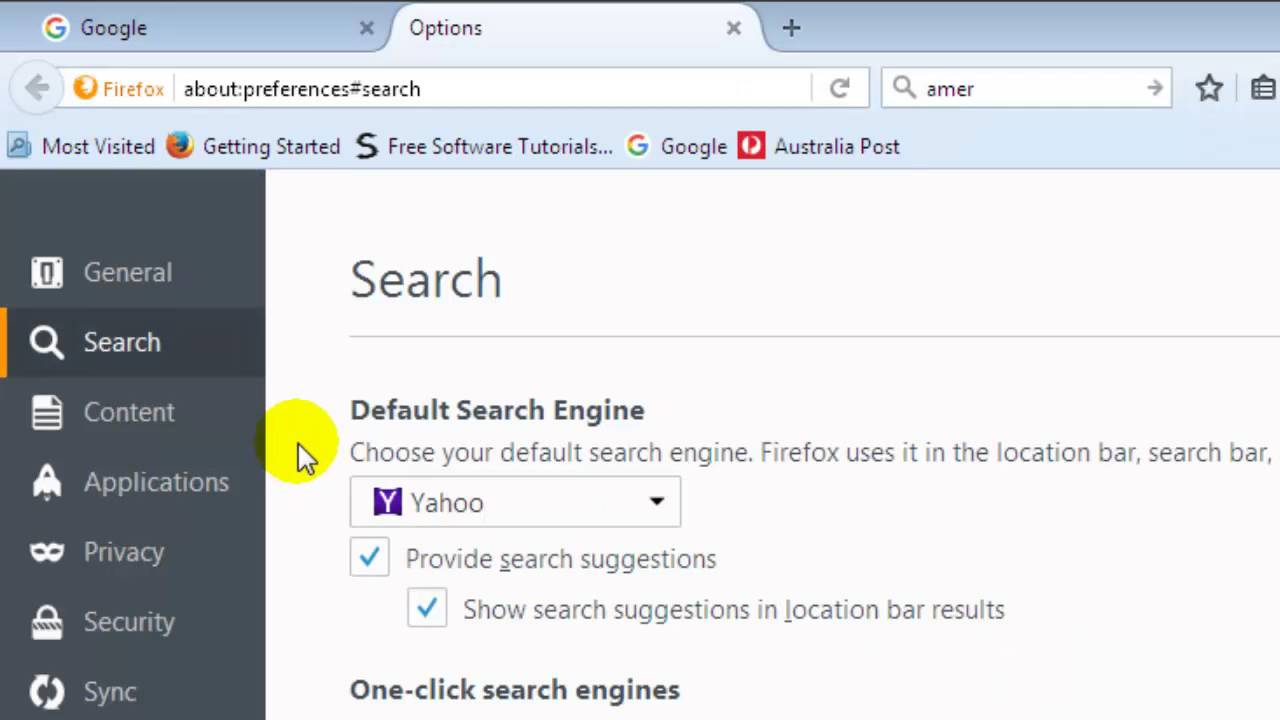Introduction
Have you ever experienced the frustration of opening your browser only to find it automatically redirecting to Yahoo? It can be incredibly annoying, especially if you prefer to use a different search engine or have specific websites set as your homepage.
This article aims to shed light on the possible reasons why your browser keeps redirecting to Yahoo and provide solutions to fix the issue. Understanding the underlying causes will enable you to take appropriate action to regain control over your browsing experience.
While Yahoo is a legitimate search engine and web portal, its sudden appearance as the default browser destination may not be to your liking. Fortunately, there are several factors that could be responsible for the redirects, ranging from browser extensions and malware to unwanted changes in browser settings.
By identifying the source of the problem and implementing the necessary fixes, you can easily resolve this frustrating issue and regain control over your browsing experience. Let’s take a closer look at some of the potential culprits behind these unwanted redirects and explore the steps you can take to rectify the situation.
Understanding the Redirects to Yahoo
If your browser keeps redirecting to Yahoo, it’s important to understand the underlying reasons behind this behavior. While it can be frustrating, especially if you prefer a different search engine or homepage, there are a few possible explanations for these redirects.
1. Browser Extensions and Add-ons: One common reason for redirects to Yahoo is the presence of browser extensions or add-ons that have modified your browser settings. Sometimes, these extensions may have been installed unintentionally when you downloaded another program or clicked on a misleading advertisement. They can modify your homepage, search engine, and even inject unwanted ads into your browsing experience.
2. Browser Hijacking Malware: Malware can also be responsible for redirecting your browser to Yahoo. Browser hijacking malware, in particular, is designed to take control of your browser and redirect you to certain websites without your consent. This type of malware can be quite sophisticated, making it challenging to remove without the help of reputable antivirus software.
3. Unwanted Browser Settings Changes: In some cases, changes to your browser settings may have occurred without your knowledge or consent. This could be due to a software update, a change made by another user on the same device, or even the accidental click on a pop-up notification. These changes can include modifying your default search engine or setting Yahoo as your homepage.
4. Toolbar or Plugin Installed Without Consent: Certain toolbars or plugins, often bundled with other software, may have been installed on your computer without your knowledge. These can alter your browser settings and cause redirects to Yahoo or other search engines. It’s crucial to be vigilant during software installations and uncheck any boxes related to additional toolbars or plugins.
5. Default Search Engine Modification: Some programs or malware may forcefully change your default search engine to Yahoo without your permission. This means that every time you launch your browser or search for something using the address bar, your queries will be directed through Yahoo’s search engine.
6. PUPs and Adware Programs: Potentially Unwanted Programs (PUPs) and adware are types of software that may have been unknowingly installed on your computer. These programs are often bundled with freeware or shareware and can inject ads, modify browser settings, and redirect your searches to unwanted websites, including Yahoo.
Now that we have a better understanding of the possible causes behind the redirects, it’s time to explore the different solutions available to fix this frustrating issue. In the next section, we will discuss the step-by-step methods you can follow to regain control of your browser and prevent further redirects to Yahoo.
Browser Extensions and Add-ons
One of the primary factors that may be causing your browser to redirect to Yahoo is the presence of unwanted browser extensions or add-ons. These can modify your browser settings, including your homepage and default search engine settings, without your knowledge or consent.
Browser extensions and add-ons are small software programs that enhance the functionality of your browser by adding new features or modifying existing ones. While there are many legitimate and useful extensions available, some can be intrusive and may redirect your browsing activities to undesired websites, such as Yahoo.
To tackle this issue, follow these steps:
- Access your browser’s extensions/add-ons settings: The way to access this setting differs depending on the browser you are using. In Google Chrome, for example, you can access it by clicking on the three-dot menu icon, selecting “More Tools,” and then clicking on “Extensions.” In Firefox, you can find it by clicking on the three-line menu icon, selecting “Add-ons,” and then navigating to the “Extensions” section.
- Review the installed extensions/add-ons: Take a closer look at the list of extensions/add-ons installed on your browser. Look for anything suspicious, unfamiliar, or that you don’t recall installing. Malicious extensions/add-ons often have generic names or names that mimic popular and trusted tools.
- Remove or disable suspicious extensions/add-ons: If you identify any suspicious extensions/add-ons, remove or disable them by clicking on the corresponding options. This will help eliminate the possibility of these extensions/add-ons redirecting your browser to Yahoo.
- Clear your browser cache: After removing or disabling the suspicious extensions/add-ons, it’s a good idea to clear your browser’s cache. This will ensure that any lingering traces or temporary files associated with these extensions/add-ons are properly cleared.
Keep in mind that not all extensions/add-ons are harmful, and you should only remove those that you are certain are causing the redirects. If you’re unsure about any particular extension/add-on, you can search for its name online to check if it has a reputation for causing such issues.
By addressing the presence of unwanted browser extensions/add-ons, you can greatly reduce the likelihood of your browser redirecting to Yahoo or any other unwanted websites. In the next section, we will discuss another common cause of these redirects: browser hijacking malware.
Browser Hijacking Malware
If your browser continues to redirect to Yahoo despite removing suspicious extensions and add-ons, there is a possibility that your computer is infected with browser hijacking malware. This type of malware is specifically designed to take control of your browser and redirect your online activities without your consent.
Browser hijacking malware is typically acquired unintentionally through malicious downloads, infected email attachments, or by visiting compromised websites. Once installed on your system, it alters your browser settings and redirects your searches to unwanted websites, including Yahoo.
To combat browser hijacking malware and regain control of your browser, follow these steps:
- Install reputable antivirus software: Start by installing a reliable and up-to-date antivirus software on your computer. Perform a full system scan to detect and remove any malware or infections. Ensure that you choose a reputable antivirus program from a trusted source.
- Update your operating system and software: Keeping your operating system and applications updated helps protect your computer from potential vulnerabilities. Malware often exploits outdated software to gain access to your system. Make sure to regularly check for and install updates for your operating system and software.
- Enable real-time detection and protection: Configure your antivirus software to provide real-time detection and protection. This feature monitors your computer in real-time, scanning incoming files and blocking malicious activities before they can cause damage.
- Be cautious while browsing and downloading: Exercise caution when visiting unfamiliar websites and downloading files from the internet. Avoid clicking on suspicious links or downloading files from untrusted sources, as they could potentially contain malware.
- Regularly scan your computer: In addition to the initial system scan, it is recommended to run regular scans to ensure there are no new malware infections present. Schedule periodic scans with your antivirus software to proactively detect and remove any threats.
Browser hijacking malware can be persistent, and removing it may require the expertise of specialized tools or assistance from a professional. If you’re unable to remove the malware yourself, consider seeking support from a reputable computer technician or reaching out to the customer support of your antivirus software.
By taking the necessary steps to identify and remove browser hijacking malware, you can prevent further redirects to Yahoo and ensure a safer browsing experience. In the next section, we will address the issue of unwanted changes in browser settings and how to resolve them.
Unwanted Browser Settings Changes
If your browser keeps redirecting to Yahoo, it is possible that unwanted changes have been made to your browser settings. These changes can occur due to various reasons, such as software updates, accidental clicks, or even the actions of another user on the same device.
To resolve the issue of unwanted browser settings changes, follow the steps below:
- Access your browser settings: Open your browser and locate the settings menu. The location of this menu may vary depending on the browser you are using. In Google Chrome, you can find it by clicking on the three-dot menu icon in the top right corner and selecting “Settings.” In Firefox, you can access it by clicking on the three-line menu icon, selecting “Options,” and navigating to the “General” or “Home” tab.
- Check your homepage settings: In the browser settings, look for the homepage configuration. Ensure that the homepage is set to the desired website or a blank page. If you find Yahoo listed as the homepage, edit it and replace it with your preferred website or a blank page.
- Review your default search engine: Look for the default search engine settings in your browser settings and verify that it is set to your preferred search engine. If it is set to Yahoo or another undesired search engine, change it to your preferred option.
- Disable automatic redirects: Some browsers have settings that allow websites to automatically redirect you to other pages. Disable this feature to prevent unwanted redirects. Look for options such as “Enable automatic page redirects” or “Prevent websites from redirecting” and ensure that they are turned on.
- Clear cache and cookies: Clearing your browser’s cache and cookies can also help resolve issues related to unwanted browser settings changes. This will remove any temporary files and stored data that could be causing conflicts.
After making the necessary changes to your browser settings and clearing the cache and cookies, restart your browser and check if the redirects to Yahoo persist. If the issue persists, proceed to the next step or consider seeking further assistance.
Unwanted changes in browser settings can sometimes be the result of malware or unwanted software on your computer. In the next section, we will discuss the possibility of unwanted toolbars or plugins causing the redirects to Yahoo.
Toolbar or Plugin Installed Without Consent
If your browser continues to redirect to Yahoo, it is possible that a toolbar or plugin has been installed on your computer without your consent. These unwanted additions can modify your browser settings, including your homepage and search engine, and cause redirects to Yahoo or other undesired websites.
To address this issue, follow the steps below:
- Access your browser’s extensions or add-ons settings: Open your browser and navigate to the extensions or add-ons settings. The method to access this setting may vary depending on the browser you are using. In Google Chrome, you can access it by clicking on the three-dot menu icon, selecting “More Tools,” and then clicking on “Extensions.” In Firefox, you can find it by clicking on the three-line menu icon, selecting “Add-ons,” and navigating to the “Extensions” section.
- Review the installed toolbars and plugins: Take a close look at the list of installed toolbars and plugins. Look for any unfamiliar or suspicious entries that you don’t remember installing. Often, these unwanted toolbars and plugins have generic names or may mimic popular and trusted ones.
- Remove or disable suspicious toolbars and plugins: Identify any suspicious toolbars or plugins and remove or disable them by clicking on the corresponding options. This will eliminate the possibility of these unwanted additions redirecting your browser to Yahoo.
- Clear your browser cache: After removing or disabling the suspicious toolbars or plugins, clear your browser’s cache. This will ensure that any residual files related to these additions are properly deleted.
Keep in mind that not all toolbars or plugins are harmful, and you should only remove those that you are sure are causing the redirects. If you are unsure about a particular toolbar or plugin, you can search for its name online to check if it is known for causing such issues.
In addition to removing unwanted toolbars and plugins, it is essential to be cautious when installing software or updates on your computer. Often, these unwanted additions are bundled with freeware or shareware programs. During the installation process, carefully read each step and uncheck any boxes related to installing additional toolbars or plugins.
By addressing the presence of unwanted toolbars and plugins, you can significantly reduce the chances of your browser redirecting to Yahoo or other undesired websites. In the next section, we will discuss how to restore your default search engine settings to resolve the issue.
Default Search Engine Modification
If your browser keeps redirecting to Yahoo, it is possible that the default search engine settings have been modified without your consent. Certain programs or malware can forcefully change your default search engine to Yahoo, redirecting your searches through their search engine.
To address this issue and restore your preferred default search engine, follow the steps below:
- Access your browser settings: Open your browser and navigate to the settings menu. The method to access this setting may vary depending on the browser you are using. In Google Chrome, you can find it by clicking on the three-dot menu icon in the top right corner and selecting “Settings.” In Firefox, you can access it by clicking on the three-line menu icon, selecting “Options,” and navigating to the “Search” or “General” tab.
- Locate the default search engine settings: Look for the section in your browser settings that allows you to modify the default search engine. In this section, you should see a list of available search engines.
- Set your preferred search engine as default: Locate your preferred search engine in the list and select it as the default search engine. Choose from popular search engines like Google, Bing, or DuckDuckGo.
- Remove Yahoo as a search engine: If Yahoo is listed as one of the search engines, remove it from the list. Most browsers allow you to remove search engines by hovering over the entry and clicking on the “X” button or selecting the “Remove” option.
- Save and apply the changes: Once you have set your preferred search engine as default and removed Yahoo (if necessary), save and apply the changes in your browser settings.
After making these modifications, restart your browser and perform a few test searches to ensure that the default search engine has been successfully updated. If the redirects to Yahoo persist, proceed to the following section to tackle the potential presence of PUPs and adware programs on your computer.
It’s important to note that modifying the default search engine settings may not be enough to completely remove the underlying issue. In some cases, the presence of potentially unwanted programs (PUPs) or adware on your computer may continue to cause redirects. In the next section, we will discuss how to address this possible cause of the problem.
PUPs and Adware Programs
If your browser continues to redirect to Yahoo even after addressing the previous potential causes, the presence of potentially unwanted programs (PUPs) or adware on your computer could be responsible for the redirects. These programs are often installed unknowingly alongside freeware or shareware, and they can inject ads, modify browser settings, and redirect your searches to unwanted websites.
To tackle the issue of PUPs and adware programs, follow these steps:
- Scan your computer with reputable antivirus software: Start by scanning your computer with a reliable and up-to-date antivirus program. The antivirus software will detect and remove any PUPs or adware that may be causing the redirects. Ensure that you choose a reputable antivirus program from a trusted source.
- Consider using additional malware removal tools: If your antivirus software does not identify any threats or is unable to remove them, you may need to utilize specialized malware removal tools. These tools are designed to specifically target and remove stubborn PUPs and adware.
- Update your operating system and software: Keeping your operating system and applications up to date is essential for the security and stability of your computer. Regularly check for and install updates for your operating system and software to ensure any known vulnerabilities are patched.
- Be cautious when downloading or installing software: Exercise caution when downloading and installing software from the internet. Read the terms and conditions, and be vigilant during the installation process to avoid inadvertently installing additional programs or adware. Uncheck any boxes related to additional software installations that you do not want.
- Regularly review installed programs and remove suspicious ones: Regularly review the list of installed programs on your computer and check for any unfamiliar or suspicious software. Uninstall any programs that you do not recognize or remember installing, as they could be PUPs or adware.
If you encounter difficulties in removing PUPs or adware on your own, consider seeking assistance from a reputable computer technician or reaching out to the customer support of your antivirus software for further guidance.
Resolving the issue of PUPs and adware programs is crucial to regaining control over your browser and preventing further redirects to Yahoo. Once you have taken the necessary steps to remove these unwanted programs, test your browser to ensure the redirects have stopped. Continue to practice safe browsing habits to minimize the chances of encountering similar issues in the future.
Now that we have discussed different potential causes and solutions for browser redirects to Yahoo, let’s summarize the steps covered in the next section.
Fixing the Issue:
To fix the issue of your browser redirecting to Yahoo, it is essential to address the potential causes discussed in previous sections. By following these steps, you can regain control of your browsing experience:
- Check and remove suspicious extensions: Access your browser’s extension settings, review the installed extensions, and remove any suspicious or unwanted ones. Clear your browser’s cache afterward.
- Scan and remove malware: Install reputable antivirus software and perform a full system scan to detect and remove any malware or browser hijacking programs. Keep your operating system and software up to date to minimize vulnerabilities.
- Reset browser settings: If unwanted changes have been made to your browser settings, utilize the settings menu to restore the default homepage, search engine, and other relevant settings. Clear your browser’s cache after making the changes.
- Uninstall unwanted toolbars and plugins: Navigate to your browser’s extensions/add-ons settings, review the installed toolbars and plugins, and remove any unwanted or suspicious ones. Clear your browser’s cache again to ensure any remnants are removed.
- Restore default search engine: Verify that your preferred search engine is set as the default in your browser’s settings, and remove Yahoo or any other undesired search engines from the list.
- Remove PUPs and adware programs: Scan your computer with reputable antivirus software to detect and remove potentially unwanted programs and adware. Consider using specialized malware removal tools if needed.
Following these steps should help resolve the issue of your browser redirecting to Yahoo. It is important to note that the specific steps may vary slightly depending on the browser you are using. Be sure to refer to your browser’s documentation or support resources for detailed instructions if needed.
By addressing the potential causes and taking appropriate action, you can regain control over your browser and prevent further redirects to Yahoo. Remember to remain vigilant while browsing the internet and exercise caution when downloading or installing software to minimize the risk of encountering similar issues in the future.
Checking and Removing Suspicious Extensions
One of the primary steps to resolve the issue of your browser redirecting to Yahoo is to check for and remove any suspicious extensions. These extensions could be responsible for modifying your browser settings and causing the unwanted redirects.
Follow these steps to check and remove suspicious extensions from your browser:
- Access your browser’s extension settings: Open your browser and navigate to the settings menu. Depending on the browser you are using, the method to access the extension settings may vary. In Google Chrome, you can find it by clicking on the three-dot menu icon in the top right corner and selecting “More Tools,” then “Extensions.” In Firefox, you can access it by clicking on the three-line menu icon, selecting “Add-ons,” and then navigating to the “Extensions” section.
- Review the installed extensions: Take a close look at the list of installed extensions. Look for any unfamiliar or suspicious extensions that you don’t remember installing. Sometimes, these extensions may have generic names or names that imitate popular and trusted ones.
- Remove suspicious extensions: If you identify any suspicious extensions, it is recommended to remove them from your browser. Click on the corresponding options, such as “Remove” or “Disable,” to eliminate the possibility of these extensions causing the redirects. Be cautious and only remove the extensions that you are certain are causing the issue.
- Clear your browser cache: After removing the suspicious extensions, it is advisable to clear your browser’s cache. This will help ensure that any temporary files or remnants associated with the extensions are properly cleared from your system.
It is important to note that not all extensions are harmful. Some may be legitimate and useful for your browsing experience. Exercise caution when removing extensions and only remove those that you are sure are causing the redirects or those that you don’t recognize.
Regularly reviewing and managing your browser’s extensions can help you maintain a clean and secure browsing environment. If you are unsure about a specific extension, you can search for its name online to gather more information about its functions and potential risks.
By checking for and removing suspicious extensions, you can eliminate one of the potential causes of your browser redirecting to Yahoo. However, if the redirects persist, proceed to the next step for further troubleshooting.
Scanning and Removing Malware
If your browser continues to redirect to Yahoo despite removing suspicious extensions, it’s crucial to scan and remove any malware that may be causing the redirects. Malicious software can alter your browser settings and manipulate your online experience without your consent.
Follow these steps to scan and remove malware from your computer:
- Install reputable antivirus software: Start by installing reliable and up-to-date antivirus software on your computer. Choose a reputable antivirus program from a trusted source and ensure it has real-time scanning and automatic updates.
- Perform a full system scan: Launch the antivirus software and initiate a full system scan. This comprehensive scan will thoroughly search for any malware or malicious files on your computer, including the ones that could be causing the redirects to Yahoo.
- Quarantine or remove detected malware: Once the scan is complete, carefully review the detected malware and follow the recommended actions provided by your antivirus software. In most cases, you will have the option to either quarantine or remove the identified threats.
- Update your operating system and software: Keeping your operating system and software up to date is essential for your computer’s security. Regularly install the latest updates and patches as they often include important security fixes that can help protect your system from malware infections.
- Enable real-time scanning and protection: Configure your antivirus software to provide real-time scanning and protection. This feature monitors your computer actively, scanning incoming files and blocking any malicious activities before they can harm your system.
It is important to note that some malware may be difficult to remove manually. In such cases, consult the documentation or support provided by your antivirus software, as they may have specialized tools or instructions to handle specific types of malware.
Running regular scans with your antivirus software is essential to detect and remove any new malware infections that may arise. Schedule periodic scans to proactively safeguard your computer’s security and prevent further redirects to Yahoo or other unwanted websites.
By scanning and removing malware from your computer, you can effectively eliminate one of the potential causes of browser redirects to Yahoo. However, if the issue persists, proceed to the next step for further troubleshooting.
Resetting Browser Settings
If your browser continues to redirect to Yahoo, resetting your browser settings can help resolve the issue. Resetting the settings will revert your browser back to its default configuration, eliminating any unwanted changes that may be causing the redirects.
Follow these steps to reset your browser settings:
- Access your browser settings: Open your browser and locate the settings menu. The method to access the settings may vary depending on the browser you are using. In Google Chrome, you can find it by clicking on the three-dot menu icon in the top-right corner and selecting “Settings.” In Firefox, you can access it by clicking on the three-line menu icon, selecting “Options,” and navigating to the “General” or “Privacy & Security” tab.
- Look for the reset option: Within the browser settings, search for an option related to resetting or restoring your browser settings. The exact location and wording may differ based on the browser you are using. Look for phrases like “Reset settings to their original defaults” or “Restore default settings.”
- Confirm the reset: Before proceeding with the reset, you will typically be presented with a warning or confirmation prompt. Read the information carefully to understand the consequences of the reset, such as the loss of saved passwords or bookmarks. If you are comfortable proceeding, confirm the reset.
- Restart your browser: After resetting your browser settings, close and relaunch your browser to apply the changes. Allow some time for the browser to fully initialize after the reset.
Resetting your browser settings can help remove any unwanted modifications, including changes made to your homepage, search engine, and other settings. It essentially returns your browser to its default state, free from any alterations that could be causing the redirects to Yahoo.
However, be aware that resetting your browser settings will also remove any customized preferences and settings you have made. Make sure to take note of any important settings or bookmarks before proceeding with the reset.
If the redirects to Yahoo persist after resetting your browser settings, proceed to the next step in order to tackle the potential presence of unwanted toolbars or plugins causing the issue.
Uninstalling Unwanted Toolbars and Plugins
If your browser keeps redirecting to Yahoo, it is important to check for and uninstall any unwanted toolbars or plugins that might be causing the issue. These additions can modify your browser settings and trigger the redirects to Yahoo or other undesired websites.
Follow these steps to uninstall unwanted toolbars and plugins from your browser:
- Access your browser’s extensions or add-ons settings: Open your browser and navigate to the extensions or add-ons settings, depending on the browser you use. In Google Chrome, click on the three-dot menu icon in the top-right corner, select “More Tools,” and then click on “Extensions.” In Firefox, click on the three-line menu icon, select “Add-ons,” and navigate to the “Extensions” section.
- Review the installed toolbars and plugins: Take a close look at the list of installed toolbars and plugins. Look for any unfamiliar or unwanted entries that you don’t remember installing. Ensure that you pay attention to the names and descriptions of these additions.
- Remove unwanted toolbars and plugins: If you identify any unwanted toolbars or plugins, click on the corresponding options to remove them from your browser. Usually, you will find options such as “Remove,” “Disable,” or a trash bin icon next to each entry. Take caution and only remove those toolbars or plugins that you are certain are causing the redirects.
- Clear your browser’s cache: After uninstalling the unwanted toolbars and plugins, it is recommended to clear your browser’s cache. This will help ensure that any remnants or temporary files associated with these additions are properly cleared from your system.
It is important to note that not all toolbars and plugins are harmful. Some may be legitimate and provide useful functionalities. Exercise caution when removing these additions and only uninstall those that you are sure are causing the redirects or those that you don’t recognize.
Regularly reviewing and managing your browser’s toolbars and plugins is essential to maintain a clean and secure browsing experience. Avoid downloading or installing toolbars and plugins from untrusted sources, as they can introduce unwanted redirects and other security risks.
By uninstalling unwanted toolbars and plugins, you can eliminate another potential cause of your browser redirecting to Yahoo. However, if the redirects persist, proceed to the next step to address the modification of your default search engine.
Restoring Default Search Engine
If your browser continues to redirect to Yahoo, it is possible that your default search engine has been modified without your knowledge. Restoring the default search engine settings can help resolve the issue and prevent further redirects to Yahoo.
Follow these steps to restore the default search engine in your browser:
- Access your browser’s settings: Open your browser and navigate to the settings menu. The method to access the settings may vary depending on the browser you are using. For Google Chrome, click on the three-dot menu icon in the top-right corner and select “Settings.” For Firefox, click on the three-line menu icon, select “Options,” and navigate to the “Search” or “General” tab.
- Locate the default search engine settings: Within the browser settings, look for the section that handles search engine preferences. This is where you can restore the default search engine.
- Set your preferred search engine as default: In the search engine settings, locate your preferred search engine from the list and select it as the default choice. Popular search engines like Google, Bing, or DuckDuckGo are commonly available options.
- Remove Yahoo or undesired search engines: If Yahoo or other undesired search engines are listed in the search engine settings, remove them from the list. Most browsers allow you to remove search engines by hovering over the entry and clicking on the “X” icon or selecting the “Remove” option.
- Save and apply the changes: After you have set your preferred search engine as the default and removed unwanted search engines, save and apply the changes in your browser settings.
Restoring the default search engine settings ensures that your browser searches are redirected to your preferred search engine instead of Yahoo. However, it is important to note that your browser’s search engine settings might differ slightly depending on the software version or browser you are using.
By setting your preferred search engine as the default and removing Yahoo or undesired search engines from your browser’s search engine settings, you can effectively tackle the issue of your browser redirecting to Yahoo. If the redirects persist, proceed to the next step to address the potential presence of Potentially Unwanted Programs (PUPs) and adware on your computer.
Removing PUPs and Adware Programs
If your browser continues to redirect to Yahoo, it is crucial to check for and remove any Potentially Unwanted Programs (PUPs) and adware that might be causing the redirects. These programs can be unknowingly installed on your computer and interfere with your browsing experience by modifying browser settings and redirecting your searches.
Follow these steps to remove PUPs and adware programs:
- Scan your computer with reputable antivirus software: Begin by scanning your computer using reliable and up-to-date antivirus software. Choose a reputable program and perform a comprehensive scan to detect any PUPs or adware that might be responsible for the redirects. Ensure that your antivirus software provides real-time scanning and automatic updates to stay protected.
- Utilize specialized malware removal tools: If your antivirus software does not detect or remove the detected threats, consider using specialized malware removal tools. These tools are designed to target and remove stubborn PUPs and adware that might be difficult to eliminate with regular antivirus software.
- Update your operating system and software: Keeping your operating system and software updated is crucial for maintaining a secure computer system. Regularly install the latest updates and patches to ensure you have the necessary security fixes and protection against vulnerabilities that can be exploited by PUPs and adware.
- Be cautious when downloading or installing software: Exercise caution when downloading and installing software from the internet. Read the terms and conditions carefully and be attentive during the installation process to avoid inadvertently installing additional programs or adware. Uncheck any boxes related to software installations that you do not want.
- Regularly review and remove suspicious programs: Regularly review the list of installed programs on your computer and remove any suspicious or unfamiliar ones. Uninstall any programs that you do not recognize or ones that you suspect may be associated with PUPs or adware.
Eliminating PUPs and adware programs from your computer is essential to regain control over your browser and prevent further redirects. If you encounter difficulties in removing them manually, consider seeking assistance from a reputable computer technician or contacting the customer support of your antivirus software for further guidance.
By removing PUPs and adware programs, you can significantly reduce the chances of your browser redirecting to Yahoo or other unwanted websites. However, if the redirects persist, further investigation may be needed or consider reaching out to a professional for additional support.
Conclusion
Experiencing frequent redirects to Yahoo when using your browser can be frustrating and disrupt your online activities. However, by understanding the potential causes and implementing the appropriate solutions, you can regain control of your browsing experience and prevent further redirects.
In this article, we explored some of the common reasons behind browser redirects to Yahoo. These include the presence of suspicious extensions, browser hijacking malware, unwanted browser setting changes, unwanted toolbars or plugins, modifications to the default search engine, and the presence of PUPs and adware programs on your computer.
To resolve the issue, you can start by checking and removing any suspicious extensions from your browser. If the redirects persist, scan your computer with reputable antivirus software to detect and remove any malware. Resetting your browser settings can also help, as well as uninstalling any unwanted toolbars or plugins. Restoring the default search engine settings is another step to consider. Lastly, if the issue persists, removing PUPs and adware programs from your computer may be necessary.
It’s important to practice safe browsing habits moving forward, such as avoiding downloading software from untrusted sources and being vigilant during the installation process. Keeping your operating system and software up to date is also crucial for maintaining a secure browsing environment.
By following these steps and taking preventive measures, you can effectively resolve the issue of your browser redirecting to Yahoo and enjoy a smoother browsing experience. If you encounter any difficulties or the redirects persist, consider seeking help from reputable computer technicians or reaching out to the customer support of your antivirus software for further assistance.

























